



Areas of Interest: North India, Central India, and South India
Unlike the previous period, this period saw was marked by political stability that ensured and encouraged cultural florescence. The Guptas and Vakatakas were the major powers in north and central India respectively.
South however witnessed a transitionary period called the Kalabhra Interregnum. This transitionary period was known as the ‘Dark Ages’ and lasted for 300 years. Not much is known about this time.
More can be read here – http://www.gloriousindia.com/history/kalabhra_interregnum.html
NORTH INDIA
1. Political Background
Gupta Empire extended for close to 300 years – almost twice the duration of the Mauryan Empire and 1.5 times the British Empire.
The maps above illustrate how they unified the whole of Northern India by around 480 AD. The Gupta Empire saw many great rulers who patronized art, architecture, and science. No wonder it has been referred to as the Golden Age. (this remains contested. While art and culture flourished, society showed signs of degeneration).
Finally, the Guptas lost out to the Hunas.
II. Literature and Language
A. Sanskrit
Sanskrit was the court language of the Guptas. Needless to say, Classic Sanskrit literature saw tremendous development under their patronage.
Two great epics(Mahakayva), the Ramayana and the Mahabharata were compiled around 4AD. Their importance is as follows
- They served as a precursor to various other Sanskrit literature
- They are the origins of many of the stories and anecdotes of the social, religious, and cultural history of India.
- They were translated into various languages that gave them renewed relevance and meaningful reincarnation.
- These epics in turn shaped new languages providing them with substance and style.
Puranas follow the lines of epics. Some of the earlier Puranas were compiled in this era. There are 18 Mahapuranas and 19 Upa-puranas.
The Puranas were associated with the revival of Hinduism. They were in the form of stories which made them more palatable to the masses than the earlier bramanical text – the Vedas.
Besides the epics, this period also saw the development of kavya (poetry), nataka (drama) and other literature.
Two things can be noted about plays
- They do not come across tragedies.
- Characters of high social status speak Sanskrit: whereas those of lower status and women speak Prakrit. This particular feature throws light on the status of Sanskrit and Prakrit in society.
The table below summarizes the important works of this time.
| Work | Author | Type | Theme | Patronage |
| Allahabad Prasasti | Harisena | An inscription. The Allahabad Pillar also has inscriptions by Ashoka and Mughal Emperor Jahangir | Eulogy on the conquests of Samudragupta. Inscribed on the Allahabad Pillar | Samudragupta |
| Kumarasambhava | Kalidas | Mahakavya(epic poem)
| Genealogy of Lord Rama. The Ikshvakus are also known as Raghuvanshis hence the name. | |
| Raghuvamsa | Geneology of Lord Rama. The Ikshvakus are also known as Raghuvanshis hence the name. | |||
| Malavikagnimitra | Play | Story of love between Agnimitra, the Sunga Prince and the hand-maiden of his chief queen, Mālavikā. Also gives an account of his father Pushyamitra Sunga’s Rajasuya Yagna. | ||
| Vikramorvasiya | It’s a Sanskrit drama depicting the love story of Puruvas, a Vedic King and Urvashi. Puruvas is chosen to reflect the qualities of Chandragupt Vikramaditya. | |||
| Abhigyana Shakuntala | A sanskrit play which depicts the story of Dushyanta, king of Hastinapur, and Shakuntala, daughter of the sage Vishwamitra and the apsara Menaka. | |||
| Ritusamhara | Lyrical Poetry | A mini epic poem on six seasons (Ritu). Considered to be the earliest work of Kalidasa. | Chandragupta II | |
| Meghaduta | Lyrical Poetry | Cloud is a messenger. An exiled yaksha who is pining for his beloved on a lonely mountain peak. When, at the beginning of a monsoon, a cloud perches on the peak, he asks it to deliver a message to his love in the Himalayan city of Alaka. | Chandragupta II | |
| Mricchakatika | Sudraka | Plays
| Mrichhakatika means a “little clay cart’. Traces the love story of Charudatta with Vasantsena. There is a hindi movie on the same work starring Rekha and Shekhar Suman. | |
| Vinavasavadatta | ||||
| Padmaprabhritaka | Bhana (short one-act monologue) | |||
| Mudrārākṣasa | Vishakhadatta | Mudrarakshasha means “Ring of the Demon”. It narrates the ascent of Chandragupta Maurya to throne. | ||
| Swapnavasavadatta, Pancharatra, Urubhanga, Madhyama-vyayoga | Bhasa | Vatya King Udayan and his queen Vasavadatta. | ||
| Vakyapadiya | Bhartṛhari | Grammar | A treatise on Sanskrit Grammar | |
| Amarakosha | Amarasimha | Grammar | Sanskrit Grammar | Chandragupta II |
| Aryabhatiyam | Aryabhatta | Maths | Also mentions Suryasiddhanta. Aryabhatta is credited with the discovery of algebra. He formulated the area of triangle which led to the origin of Trigonometry. He *did not* invent zero. |
| Panchasiddhanta | Varahamihira | Astrology | Gives a summary of 5 schools of astrology – Surya Siddhanta, Romaka Siddhanta, Paulisa Siddhanta, Vasishtha Siddhanta and Paitamaha Siddhanta. Also discusses concepts of Trigonometry. |
| Brihatsamhita | Varahamihira | Astrology |
III. Religion
A. Hinduism
- Vaishnavism – Bhagavatism on the rise.
- Emergence of Pauranic Hinduism
The brahmanical tradition witnessed a decisive change from what was traditionally practised as “Vedic tradition”. Vedic Brahmanism gave way to Pauranic Hinduism. Sacrifices/ Rituals were not entirely abandoned but they lost their steam.
Where Vedic Brahmanism was intimately linked with lavish sacrifices and upper varna-jatis, Pauranic Hinduism became widely popular as it was open to all varna-jatis including Shudras, women, etc and encouraged the worship of a personal deity.
Its accessibility lay in performing acts that required little investments – the giving of gifts, keeping of fasts and vows, traveling collectively to places of pilgrimages, and subscribing to local mythologies.
B. Buddhism
Buddhism no longer received royal patronage, unlike the earlier times. Samudragupta’s permission to the King of Ceylon to erect a magnificent monastery in Bodh-Gaya indicates that Buddhism was given good patronage.
Nalanda prospered under their patronage.
Post 500AD it saw a new phase in Buddhism marked by the following developments
1. Homogenization with Hinduism: Hindus practiced devotion to Buddha as a reincarnation of Lord Vishnu. In a way, Hinduism went on to assimilate Buddhism as a part/ branch of its own.
2. Humble beginnings of what later comes to be known as tantric Buddhism. The new form of text associated with this tradition, the tantras, appeared during the Gupta period, and there are indications that distinctively Tantric rituals began to be employed at this time as well. Tara is a female Bodhisattva in Mahayana Buddhism who appears as a female Buddha in Vajrayana Buddhism. She is known as the “mother of liberation”, and represents the virtues of success in work and achievements.
This will later develop into a full-fledged Vajrayana cult and reach its peak during the Pala Empire.
C. Jainism
Jainism spread into Gujarat. At Valabhi, took place the compilation of two Jain canonical texts in two councils in the 4th and 5th centuries.
D. Shaktism and Tantrism
Shaktism and Tantrism are closely associated with cults. They started as different streams. Shaktism revolves around placing women at the center. Later this cult starts to be associated with Shaivism, where Shakti is seen as Shivas consort.
The name Tantrism is derived from sacred texts called tantras. The earliest works were written in the Gupta period. In the course of time, tantrism manages to penetrate all religions.
IV. Architecture
A. Stupas
1. Dhamekh Stupa
Originally built in 249 BCE during the reign of King Ashoka of the Maurya Dynasty, this massive and prominent structure has over time gone through several expansions and additions. This solid cylindrical shaped Stupa is made of red bricks and stone. The stone facing is chiseled and displays delicate floral carvings of Gupta origin.
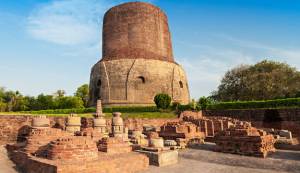
B. Caves
The earliest examples of religious architecture were cave-temples which typically had exteriors decorated with relief sculpture and a single carved doorway.
Inside the shrine, ritual sculptures were placed such as a Shiva linga, and the walls were richly decorated with more carvings showing scenes from mythology.
1. Udayagiri Caves
Note4Students – There are a number of places in India with the same name, the most notable being the mountain called Udayagiri at Rajgir in Bihar and the Udayagiri and Khandagiri caves in Orissa. The caves in Orissa correspond to Jainism.
The Udayagiri caves belonging to the Gupta period are located in Vidisha, Madhya Pradesh.
There are about 14 caves but you need to focus on only 1 of them: Cave #5 – Dedicated to the Varaha avatar of Vishnu.
This shrine is one of the finest examples of Gupta art, the celebrated relief showing Vishnu in his incarnation as the boar-headed Varaha. Varaha’s avatar rescued the Earth from the chaos of the cosmic sea.
The scholars say that when Chandragupta II (Vikramaditya) renovated the cave in this manner, he wanted to portray the rescue of Northern India from the political instability and fragmentation that it had experienced prior to the rise of the Gupta Empire.
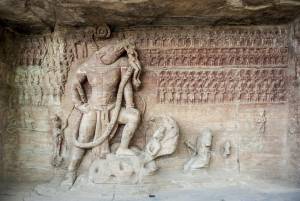
2. Junagarh Caves
The so-called “Buddhist Caves” are not actually caves, but three separate sites of rooms carved out of stone to be used as monks’ quarters.
Unique feature = Presence of a 30-50 ft high citadel-like feature – Upar Kot in front of the prayer hall
3. Bagh Caves:
Located on the bank of the Baghani River in the Dhar district of Madhya Pradesh. These rock-cut caves possess the most amazing paintings known to be made by ancient man. According to legend, these caves were established by Buddhist monk Dataka. Out of the initial 9 caves only 5 have been extant.
Bagh Caves are known for Mural Paintings – thick mud plaster in brownish orange color. The most famous features of Bagh Caves are these murals made in the tempera technique.
http://www.chinkarajourneys.com/uploads/map/Bagh_murial_painting.jpg>
Over this plaster, there was done lime-priming and then paintings were laid. This is also known as the tempera technique, which refers to the use of a permanent fast-drying painting medium consisting of colored pigment mixed with a water-soluble binder media.
4. Nasik Caves
http://www.wondermondo.com/Images/Asia/India/Maharashtra/Pand.jpg>
A group of 23 caves, also called ‘Pandav-Leni’.
These caves belong to Hinayana Buddhism (have no images of Buddhas)
Contrary to what their name suggests they have nothing to do with the characters of Mahabharata (the Pandavas).
C. Temples
Not satisfied with caves, the Guptas were the first dynasty to build permanent free-standing Hindu temples. This lay the foundation of the Nagara School of Art. Temple architecture with the development of a square sanctum and pillared portico emerged during the Gupta period.
Among the 5 stages of temple development, you will find a gradual progression from flat-roofed, monolithic temples in the initial stage to the sculptured ‘shikhara’ in the later years.
Stage #1 – Temple 17, Sanchi & Kankali Temple, Tigwa.
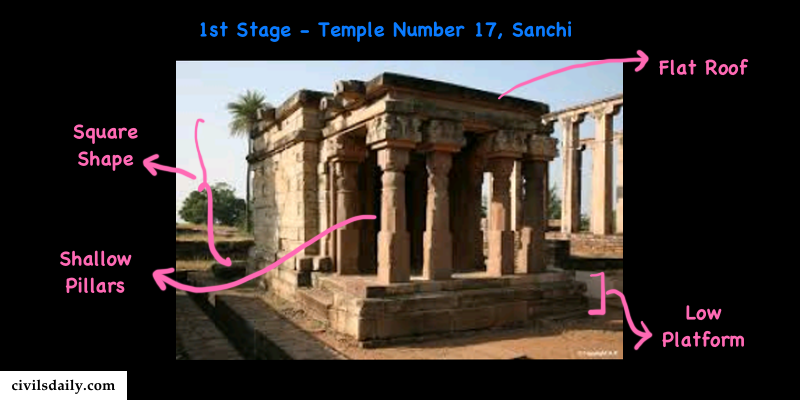
- Flat roof temples
- Square temples
- Shallow pillared approach at the front
- Low platforms
Stage #2 – Parvati Temple, Nachnakuthara, MP
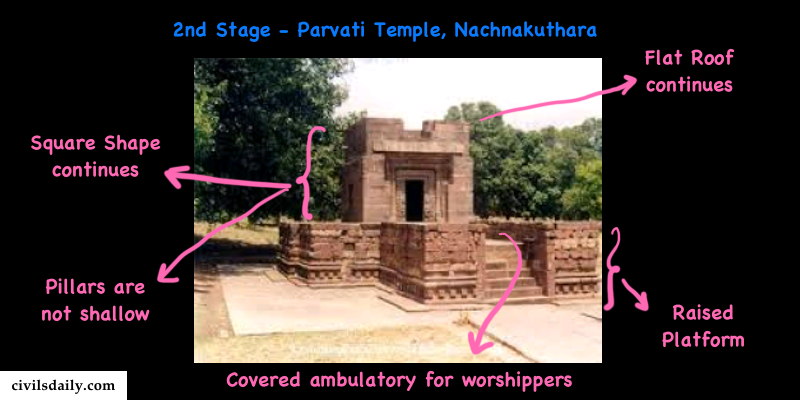
- Continued- Flat roof, square pillared approach (not shallow)
- High or upraised platforms
- Covered ambulatory around the sanctum (garbhagriha) for worshippers to do a parikrama
- Two storied temples (sometimes)
Stage #3 – Dashavatara Temple, Deogargh & Durga Temple Aihole, Karnataka
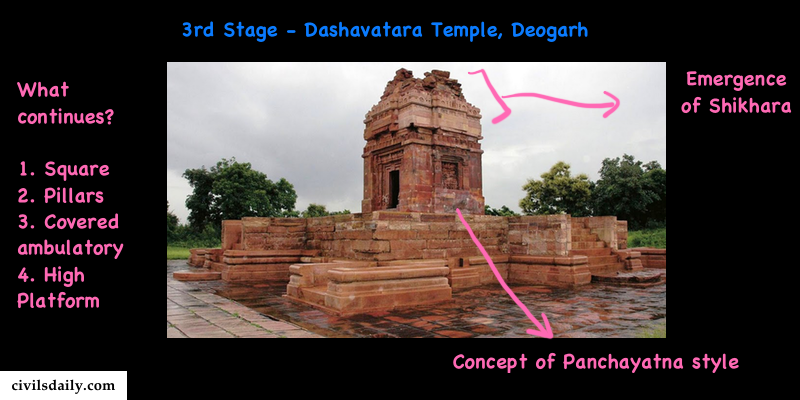
- Most of the features of 2nd stage are carried forward
- Flat roof evolved into a curvilinear roof (shikhara)
- Introduction of Panchayatan style of temple making
A Hindu temple is a Panchayatana one when the main shrine is built on a rectangular plinth with 4 subsidiary shrines at 4 corners making it a total of 5 shrines. The origin of the name is the Sanskrit words Pancha (5) et ayatana (containing).
Stage #4 – Ter Temple, Sholapur
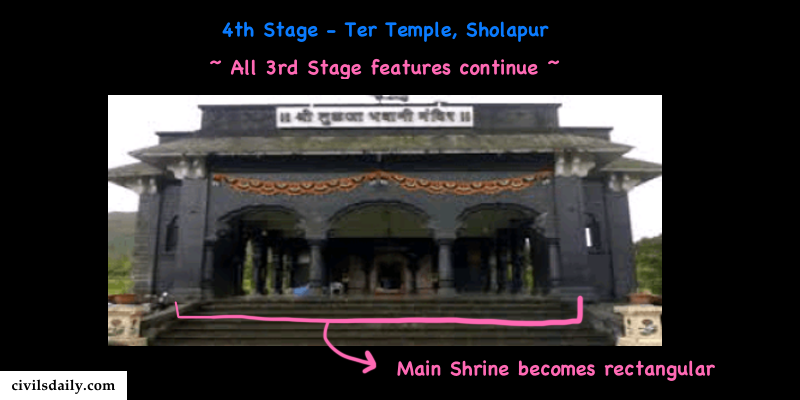
- Most of the features of 3rd stage are carried forward
- Noticable change from square to rectangular shape of the main shrine
Stage #5
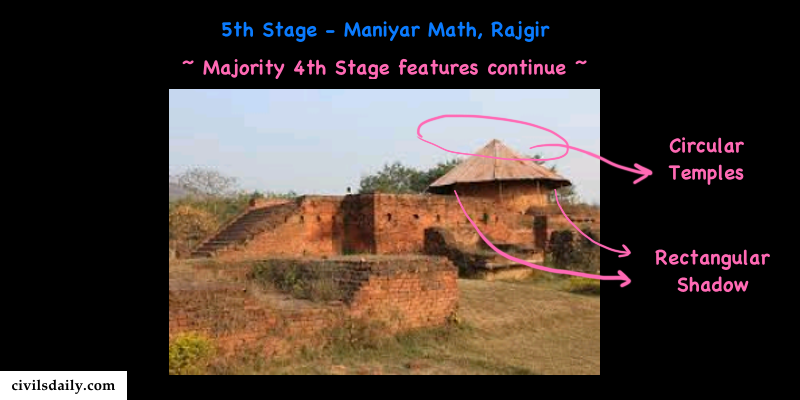
- Most of the features of 3rd stage are carried forward
- Introduction of circular temples with shallow rectangular projections
Stage 3 Temples in detail
1. Dasavatara temple, Deogarh, Uttar Pradesh
Dasavatara = Das (10) + Avatara (Incarnation). The temple depicts the 10 avataras of Vishnu.
First North Indian temple with a shikhara.
Earliest known Panchayatana temple in North India.
Two river goddesses, the Ganga and Yamuna, are mentioned as attendants of Shiva and this occurs as a regular feature of temple architecture from the doorways of the Dasavatara temple.
There are 3 main reliefs of Vishnu on the temple walls:
1. On the west – Gajendramoksha is the story of achieving moksha, symbolically communicated by Vishnu’s suppression of an asura Who had taken the form of an elephant.
2. On the east – Nara-Narayan shows the discussion between the human soul and the eternal divine.
3. On the south – The Sheshashayana Vishnu panel is a superb piece of art
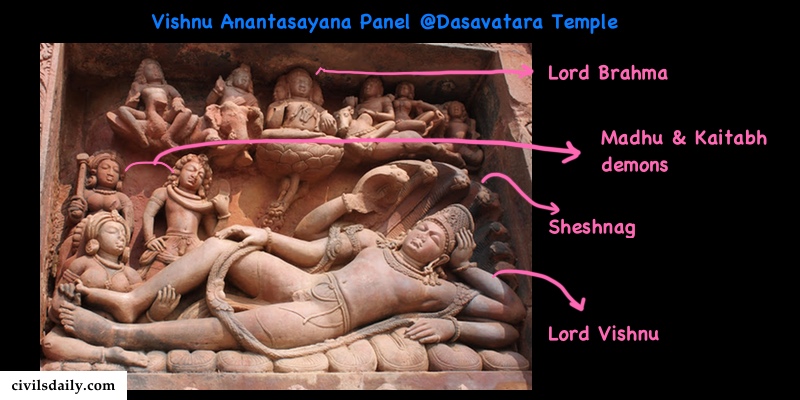
- Sheshashayana is the form of Vishnu where he is shown reclining on the sheshanaga called Ananta whose seven hoods form a canopy over his crowned head
- His consort Lakshmi is massaging his right leg and two attendant figures stand behind her
- Various gods and celestials are hovering above. Lord Brahma can be seen.
- In the lower panel, the two demons Madhu and Kaitabha, in an attacking attitude, are challenged by the four personified weapons of Vishnu
2. Bhitargaon Temple, Kanpur, Uttar Pradesh
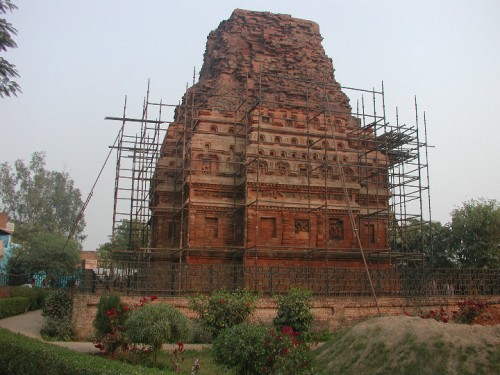
source
- The first full unit temple with a Vimana.
- It is the oldest remaining Hindu temple made entirely of bricks/terracotta.
- The temple is built on a square plan with double-recessed corners and faces east. There tall pyramidal spire over the garbhagriha.
- Terracotta sculpture depicts both secular and religious theme such as deities like ganesha adi virah mahisasaur-mardani and river goddess. Myths and stories representing abduction of Sita and the penance of nara-narayan.
3. Ahichhatra Temple (Shiva Temple)
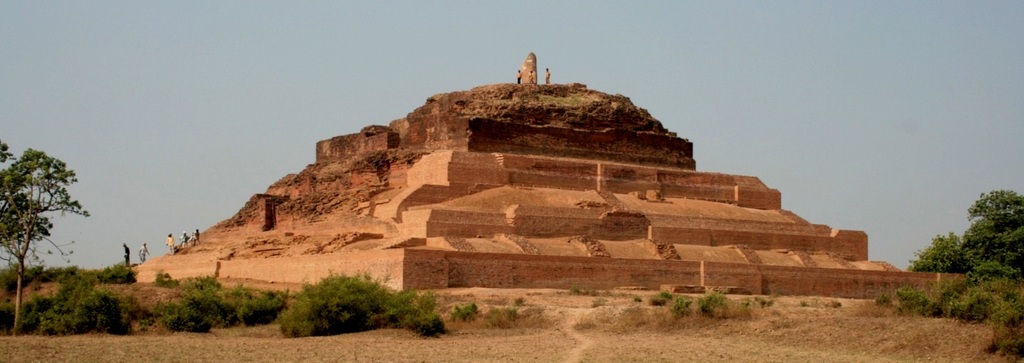
The Shiva temple at Ahichhatra belongs to the Gupta period 4th century A.D. It is famous for its two life-sized terracotta images of Ganga and Yamuna.
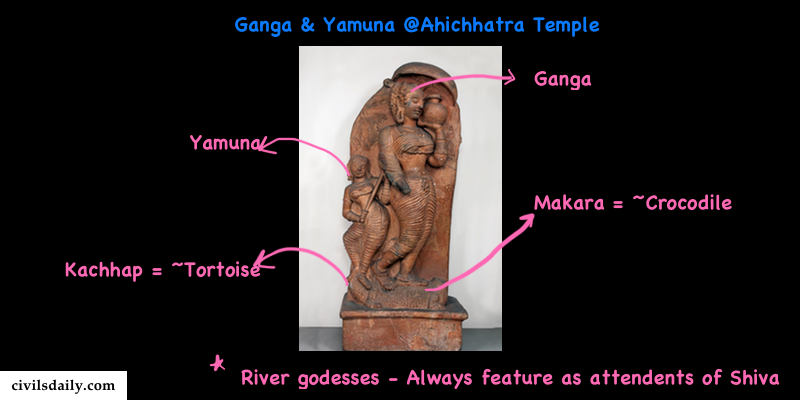
Ganga and Yamuna are installed in niches flanking the main steps leading to the upper terrace of the temple.
Ganga stands on her vehicle, the makara. and Yamuna on the kacchap.
V. Art
A. Sculpture
- Mathura School
Mathura school also witnessed some development during the Gupta period. A prominent sculpture is the Standing Buddha at Matura
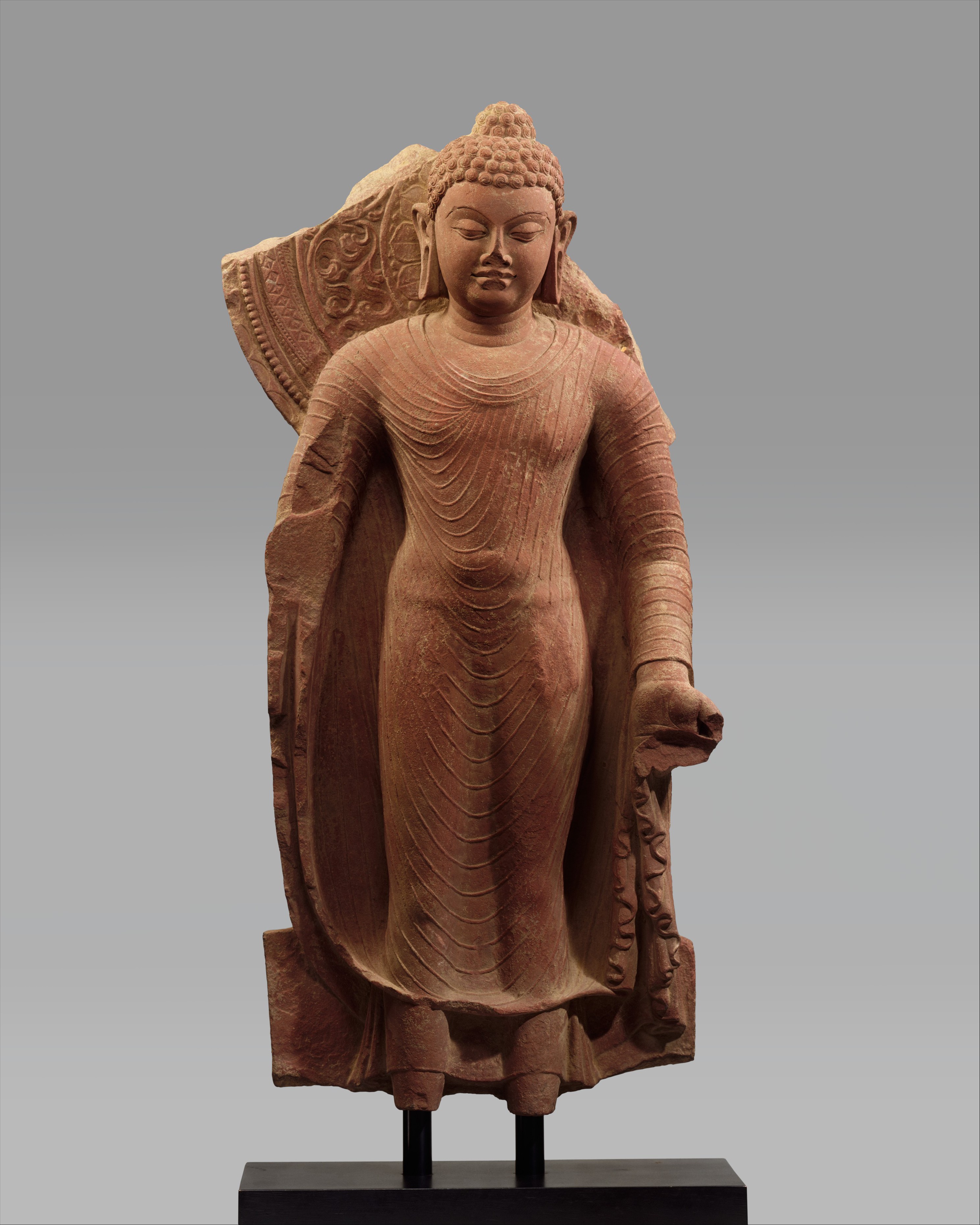
- Red sandstone image of the Buddha dated to 500AD
- Right hand in abhayamudra, assuring protection, and the left holding the hem of the garment.
- Smiling countenance with down-cast eyes is robed in spiritual ecstasy
- Robe covering both shoulders is skillfully represented with delicately covered schematic folds and clings to the body
- Head is covered with schematic spiral curls with a central protuberance and the elaborate halo decorated with concentric bands of graceful ornamentation.
2. The Sarnath School of Sculpture
The art of Bharhut, Amravati, Sanchi and Mathura came closer and closer; melting into one – The Sarnath School.
Its plasticity is derived from that of Mathura and its elegance from that of Amravati. Plasticity is a term used to describe a rich, three-dimensional or sculptural presence of a building.
The human figure takes center stage and nature becomes the background.
A prominent sculpture is Standing Buddha at Sarnath
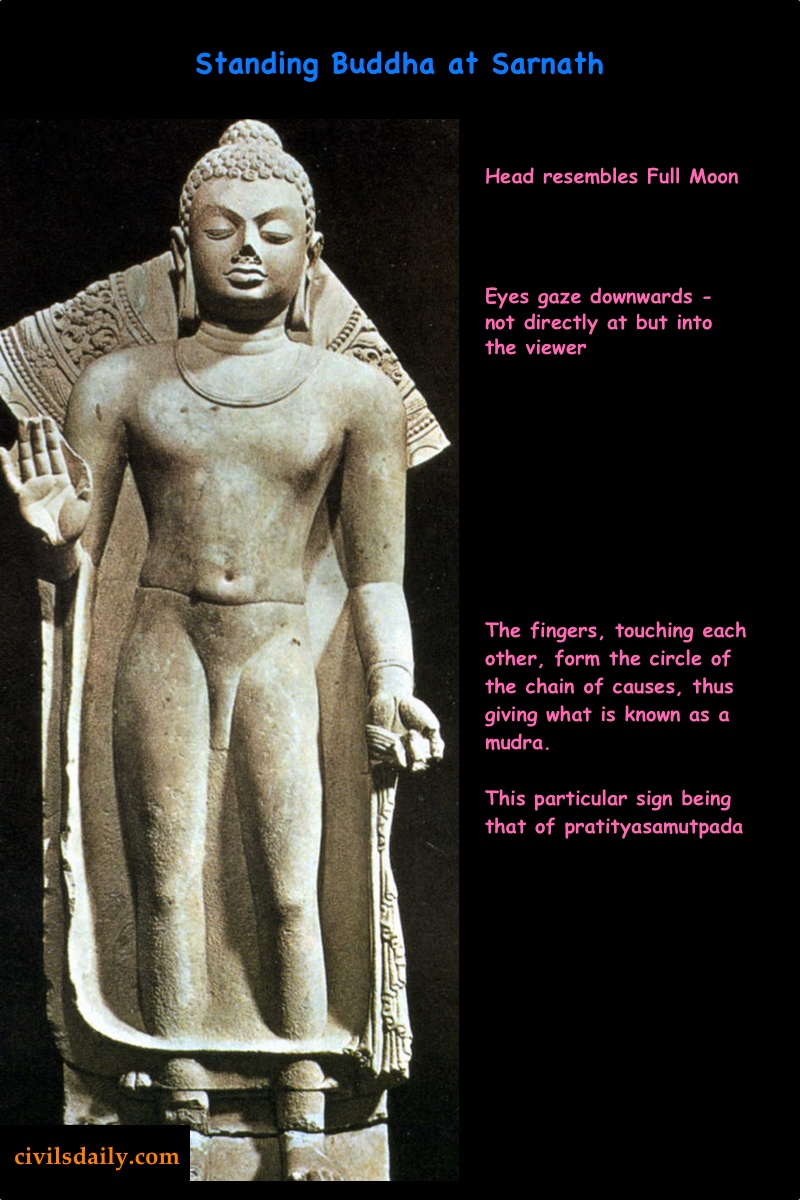
- his right hand in abhayamudra.
- Unlike the delicately carved drapery folds of the Mathura Buddha, only the fringe of the diaphanous robe is here indicated.
- The eyes gaze downward, not directly at, but into the viewer
- The very fine high-grade surface seems to have a soft bloom -a specially distinctive Sarnath quality
Difference between Sarnath and Mathura School Buddha
| Sarnath School | Mathura School |
| Relaxed attitude in the body of the sculpture. Visible bends | Mathura School had a columnar rigidity in similar works |
| Very fine draping – almost invisible on the body but left hanging out on the sides | In the Mathura School, the drapes were elaborate and folds were very much visible |
| The body in its smooth and shining plasticity constitutes the principal theme of the Sarnath artists | Mathura sculpture was more rigid |
| At Sarnath, the material used was cream colored sandstone | Mathura sculpture was made of moderately fine red sandstone. |
Follow the link for more remarkable examples or Sarnath School Sculptures
http://www.sarnathmuseumasi.org/Gallery-No1.aspx
http://varanasi.nic.in/history/ams1.html
References and image credits:
Mudras – http://www.buddhas-online.com/mudras.html

